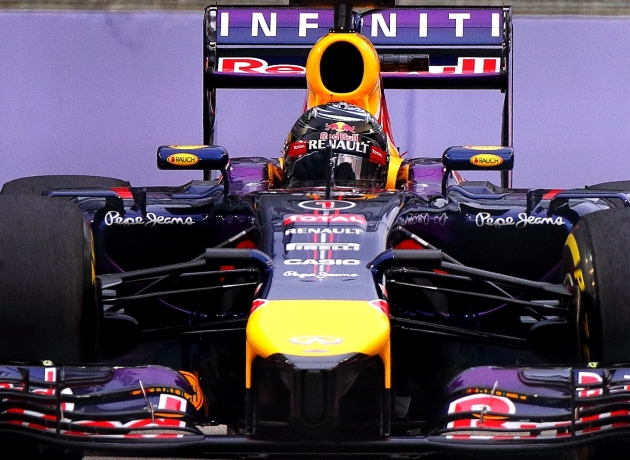The 2014 Formula 1 Singapore Grand Prix
I couldn’t believe my ears when I heard that the 2014 Singapore Formula One Grand Prix was in its 7th installment – the Singapore F1 Grand Prix will be a 10 year old event when the contract expires in 2017! Somehow the annual event never runs out of steam, with the pulsating and adrenalin-filled event being a mainstay of our calendars.
Kudos must be given to the race promoter Singapore GP Pte Ltd for coming up with fresh events like the three new performance stages, an additional support race (the Masters Historic Formula One Race), a revamped dining concept, and an expanded support entertainment line-up featuring A-Listers.
When the Circuit Park gates opened at 3pm, I was amazed by the variety of specially curated off-track activities comprising world-class international music acts, theatrical performances, illusionists, and roving artistes. With some to much to do, you will feel like an F1 driver yourself, racing against time to cover all the activities in the 799,000 sqm Marina Bay Circuit.
While I attended the F1 Grand Prix five years ago, this year I visited the race with a key objective – to take better pictures. I hope to share some experience and tips picked up from my first “real” outing at the race as a photographer with any F1 enthusiasts looking to take better F1 pictures. Thanks are in order to Canon Singapore, whose loan of a professional grade lens was invaluable to capturing the moments I experienced at this event perfectly.
Photojournal of the SG F1 Grand Prix 2014
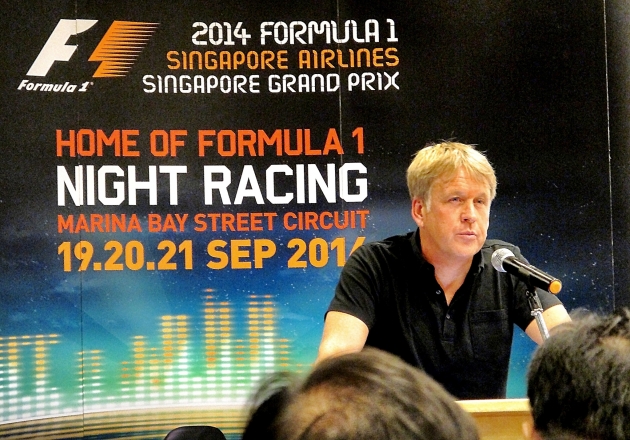 Image data : Canon G12, 1/15s, F4.58, ISO1600
Image data : Canon G12, 1/15s, F4.58, ISO1600
A few days prior to the commencement of the race, I attended an evening workshop organised by Singapore GP Pte Ltd at the Central Library. The speaker was Steven Tee, principal photographer and Managing Director of London Art Technical (LAT), a motoring photographic agency established in the 1960s. Steven is a veteran of more than 500 F1 races in the world and is one of few dedicated F1 photographers worldwide.
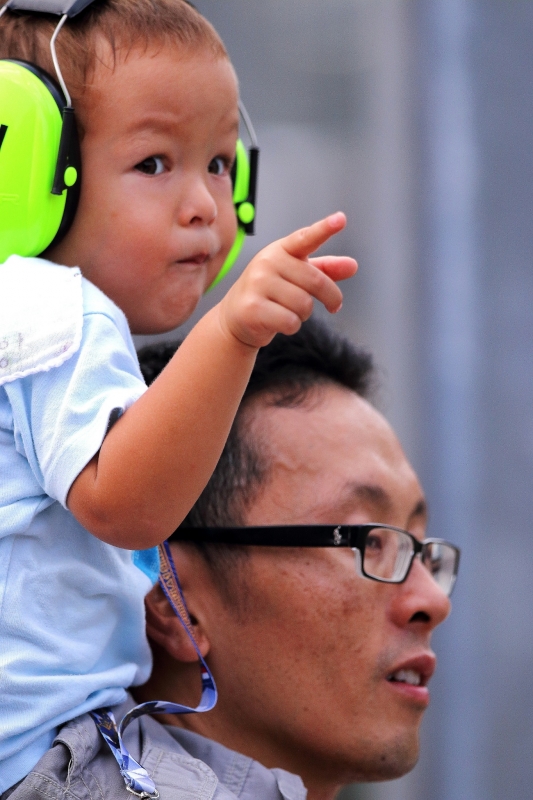 Image data : Canon 70D, Lens- EF300mm F2.8L IS Mk2, 1/2500s, F2.8, ISO500
Image data : Canon 70D, Lens- EF300mm F2.8L IS Mk2, 1/2500s, F2.8, ISO500
The race is not only about souped up race cars speeding around a circuit – it also offers great opportunity for people and street photography. Here, I spotted a child with an ear muffler on his father’s shoulders, engrossed with the speeding cars during the Porsche Carrera Cup Asia Race.
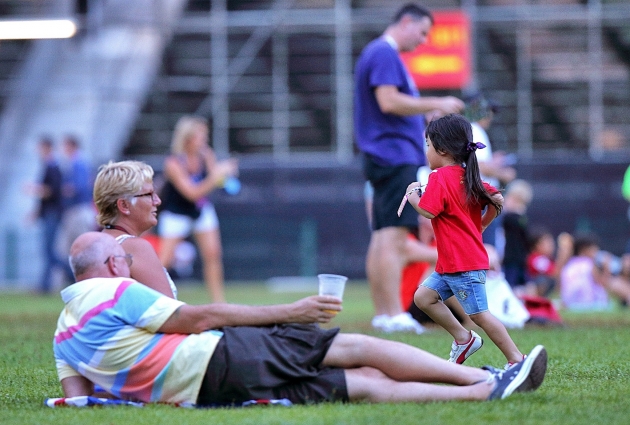 Image data : Canon 70D, Lens- EF300mm F2.8L IS Mk2, 1/800s, F3.2, ISO800
Image data : Canon 70D, Lens- EF300mm F2.8L IS Mk2, 1/800s, F3.2, ISO800
Little girl in red running at the Padang. This picture brought to mind the Ferrari Prancing Horse logo. A future race car driver perhaps!
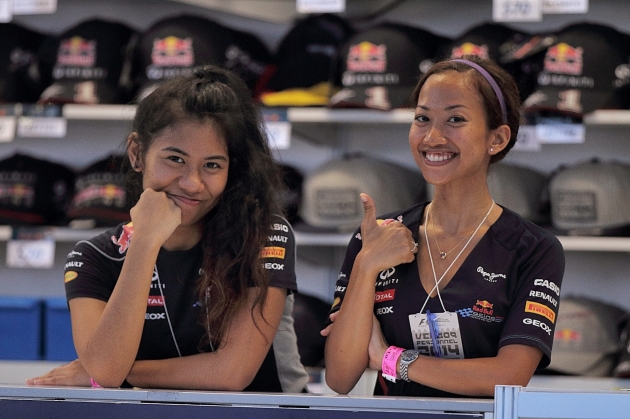 Image data : Canon 70D, Lens- EF300mm F2.8L IS Mk2, 1/200s, F2.8, ISO800
Image data : Canon 70D, Lens- EF300mm F2.8L IS Mk2, 1/200s, F2.8, ISO800
These sales girls were observant. I was standing about 40 meters away with the Canon EF300mm lens when they spotted me and struck their poses. Admittedly it’s hard to miss a photographer with the L lens, as the lens is quite prominent and is sure to attract more than a few stares.
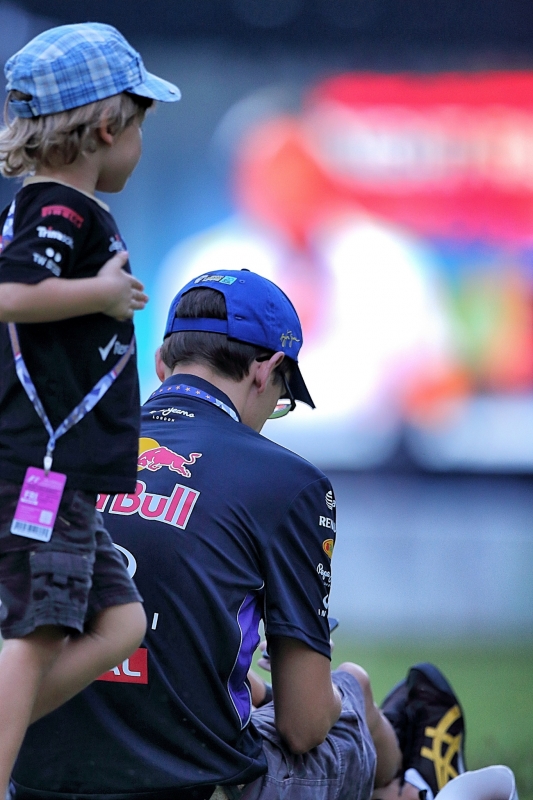 Image data : Canon 70D, Lens- EF300mm F2.8L IS Mk2, 1/800s, F2.8, ISO800
Image data : Canon 70D, Lens- EF300mm F2.8L IS Mk2, 1/800s, F2.8, ISO800
Father and son duo supporting the Red Bull Racing team. The awesome bokeh derived from the the Canon EF300mm is a joy to behold – with a creamy depth of field, and a razor sharp image wide open at F2.8.
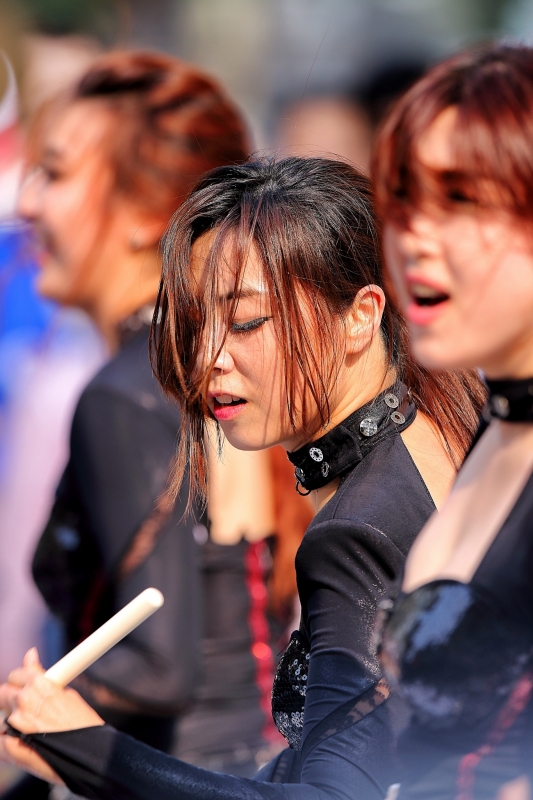 Image data: Canon 70D, Lens- EF300mm F2.8L IS Mk2, 1/400s, F3.5, ISO100
Image data: Canon 70D, Lens- EF300mm F2.8L IS Mk2, 1/400s, F3.5, ISO100
Fantastic sonic treat from Drum Cat, an all-female percussion group from Seoul at the race fringe activities. Many visitors were drawn to the performances by eye candy but were soon convinced to stay for the ear candy. Some of their accolades include the 2008 Edinburgh Festival Herald Angel award and the 2008 Scotland Cavacade Best Unit award.
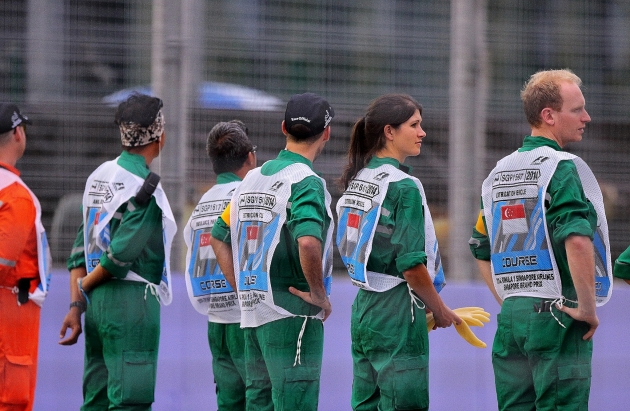 Image data : Canon 70D, Lens- EF300mm F2.8L IS Mk2, 1/4000s, F2.8, ISO1250
Image data : Canon 70D, Lens- EF300mm F2.8L IS Mk2, 1/4000s, F2.8, ISO1250
Circuit Extraction Crew at the circuit prior to the commencement of the Porsche Carrera Cup Race Asia. Yes, female crew members handle “dirty” tasks as well as any of their male counterparts.
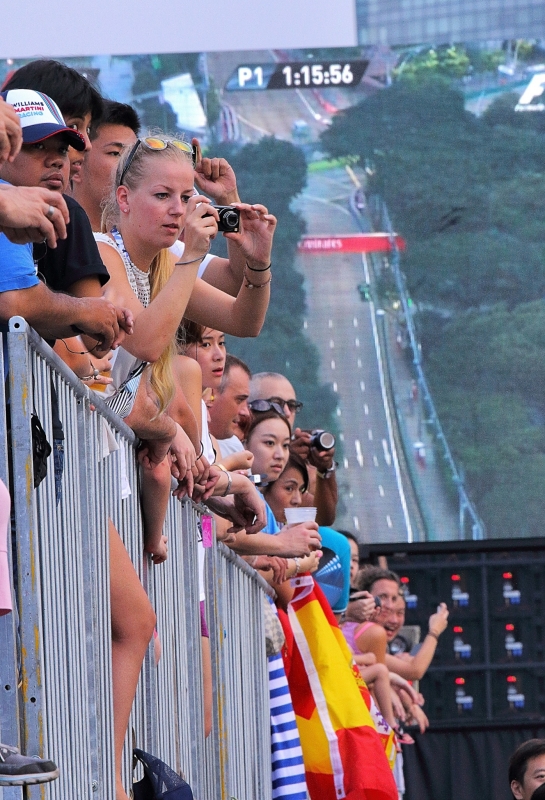 Image data : Canon 70D, Lens- EF300mm F2.8L IS Mk2, 1/50s, F20, ISO1000
Image data : Canon 70D, Lens- EF300mm F2.8L IS Mk2, 1/50s, F20, ISO1000
Spectators from all over the world lapping up the action along Esplanade Drive with a big screen providing “live” coverage of the race. The organizers certainly planned well to ensure everyone got enhanced coverage.
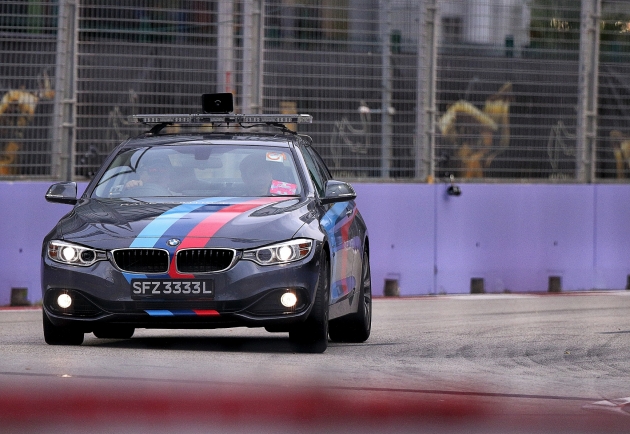 Image data : Canon 70D, Lens- EF300mm F2.8L IS Mk2, 1/4000s, F2.8, ISO1000
Image data : Canon 70D, Lens- EF300mm F2.8L IS Mk2, 1/4000s, F2.8, ISO1000
A BMW Circuit Control Car making the rounds prior to race commencement. Safety is key to minimizing the risk of accidents.
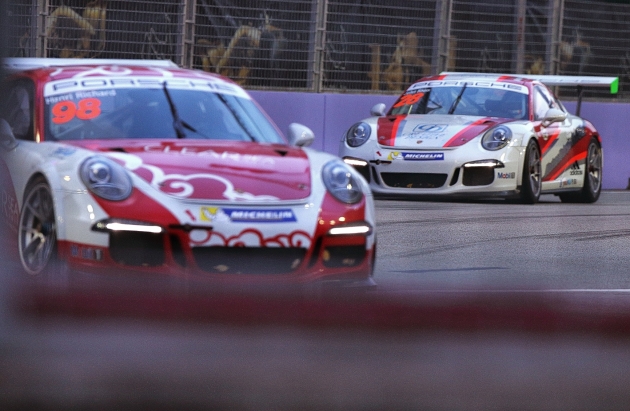 Image data : Canon 70D, Lens- EF300mm F2.8L IS Mk2, 1/2500s, F3.5, ISO800
Image data : Canon 70D, Lens- EF300mm F2.8L IS Mk2, 1/2500s, F3.5, ISO800
The Porsche Carrera Cup in progress. The cars might not be as mean and exciting and as the Formula 1 beasts, but the power they pack is hefty nonetheless.
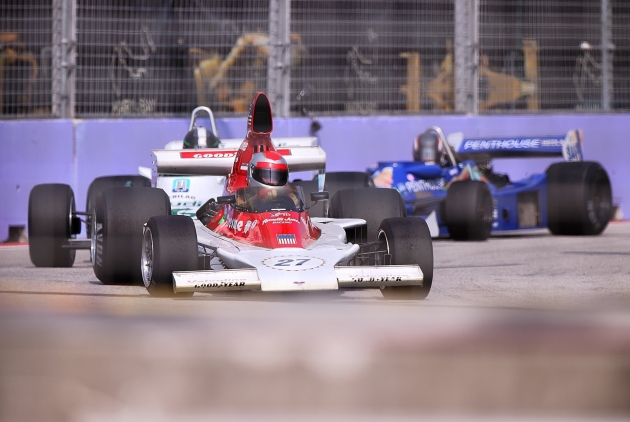 Image data : Canon 70D, Lens- EF300mm F2.8L IS Mk2, 1/3200s, F2.8, ISO100
Image data : Canon 70D, Lens- EF300mm F2.8L IS Mk2, 1/3200s, F2.8, ISO100
The Masters Historic Formula One Race. For the first time, F1 cars from the 1970s-1980s era graced the tarmac at the Marina Bay circuit. This served as a support race to the actual Singapore GP.
To some, these cars look like more muscular versions of go-karts but these are 3-litre engine F1 cars. The best part – they were much louder than the current crop of F1 cars, which some commentators already describe as “loud washing machines”.
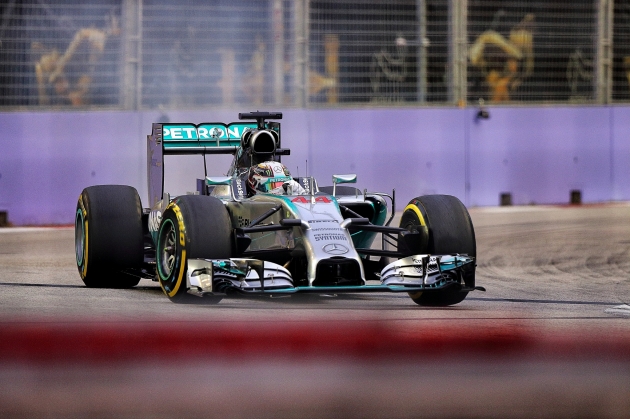 Image data : Canon 70D, Lens- EF300mm F2.8L IS Mk2, 1/1250s, F2.8, ISO500
Image data : Canon 70D, Lens- EF300mm F2.8L IS Mk2, 1/1250s, F2.8, ISO500
Eventual race winner Lewis Hamilton smoking up the chicane (turning point) at Turn 7 during the Day 1 Practice Run. However fast the cars may be, they have to slow down here – this gives you an opportunity to take clearer sharper pictures of the speed machines. After you have gained more experience, you should look out for turns where you can do a slight pan to impart a sense of movement to the cars.
This picture was shot while during my first hour at the track. On hindsight, I forgot that the ideal speed for a balance between vehicle sharpness and slight movement in the wheels is between 1/250s-1/500s.
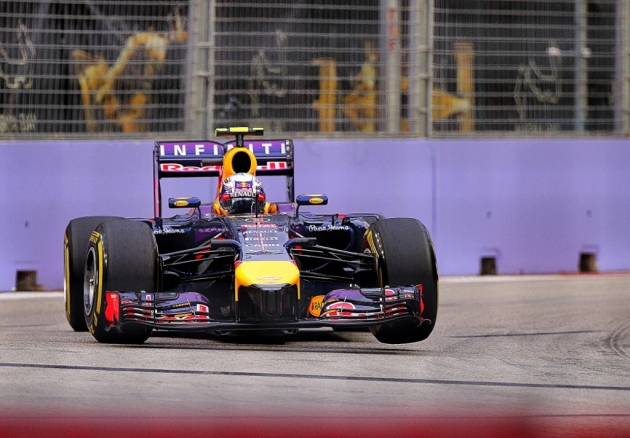 Image data : Canon 70D, Lens- EF300mm F2.8L IS Mk2, 1/1600s, F2.8, ISO500
Image data : Canon 70D, Lens- EF300mm F2.8L IS Mk2, 1/1600s, F2.8, ISO500
The turns at the circuit also present an opportunity to capture instances of the wheels going “airborne”. Here, you can see the Daniel Ricciardo (No.3) from Team Red Bull Racing going around the bend. During the initial practice and qualifying runs, you are less likely to see much action as the racers play it safe, with the bulk of the action culminating on the final race on day 3, when all hell breaks loose as the drivers go all out for the chance at a podium finish.
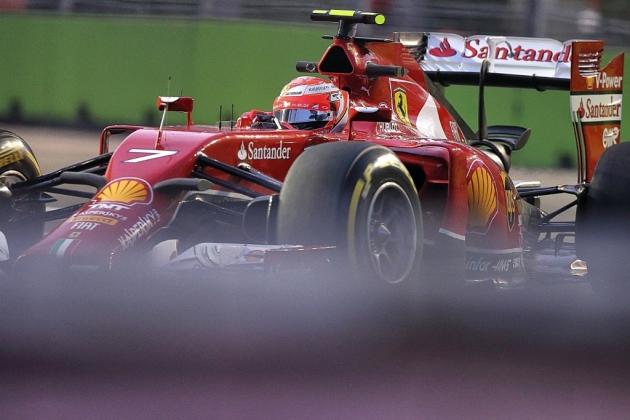 Image data : Canon 70D, Lens- EF300mm F2.8L IS Mk2, 1/1600s, F2.8, ISO1600
Image data : Canon 70D, Lens- EF300mm F2.8L IS Mk2, 1/1600s, F2.8, ISO1600
After many pictures, I realized that while pictures of a car fully in the frame are nice shots, they lack the impact that is associated photos with greater zoom. Here you can see Kimi Raikkonen (No.7) from team Scuderia Ferrari, with his hand on the steering wheel, at Turn 11. I like to occasionally include “foreground bokeh” (in this case, using the track safety barrier) for a sense of depth.
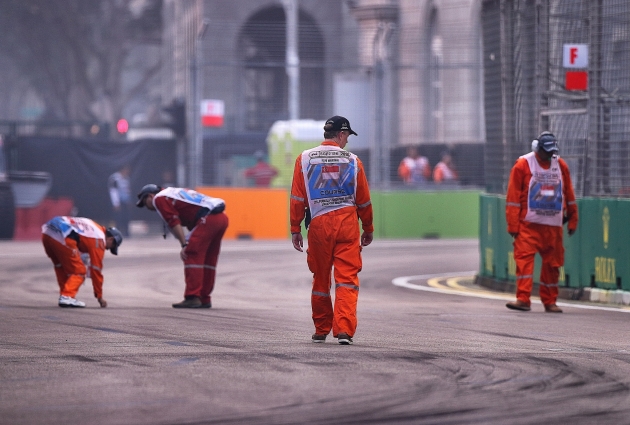 Image data : Canon 70D, Lens- EF300mm F2.8L IS Mk2, 1/1250s, F2.8, ISO250
Image data : Canon 70D, Lens- EF300mm F2.8L IS Mk2, 1/1250s, F2.8, ISO250
Pictures of circuit crew going around the track looking for foreign objects or impediments after each run are a nice contrast to the race pictures as it provides a human aspect to the event. While the race cars are the main attraction, the race would be impossible without the “invisible” support crew toiling away.
 Image data : Canon 70D, Lens- EF300mm F2.8L IS Mk2, 1/6400s, F2.8, ISO1600
Image data : Canon 70D, Lens- EF300mm F2.8L IS Mk2, 1/6400s, F2.8, ISO1600
Do read the race event guide closely to avoid missing out on interesting activities. Here, the customary Formula 1 Drivers’ Track Parade is a highlight, especially if you want to spot your motoring idols. This picture shows the track safety car leading the parade with Lewis Hamilton and Nico Rosberg in the background.
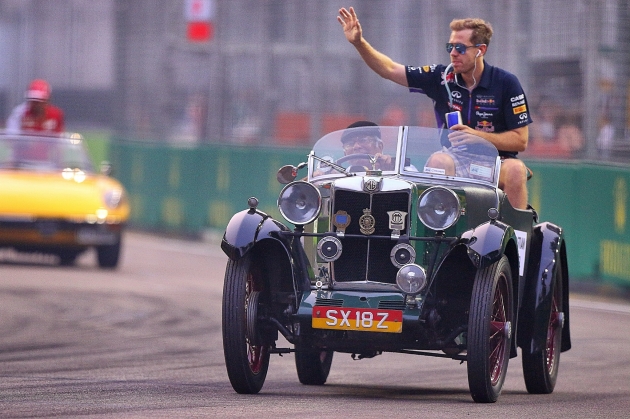 Image data : Canon 70D, Lens- EF300mm F2.8L IS Mk2, 1/1600s, F2.8, ISO1600
Image data : Canon 70D, Lens- EF300mm F2.8L IS Mk2, 1/1600s, F2.8, ISO1600
The combination of Singapore’s humidity and the heat in his mean machine has Sebastian Vettel keeping himself hydrated during the parade.
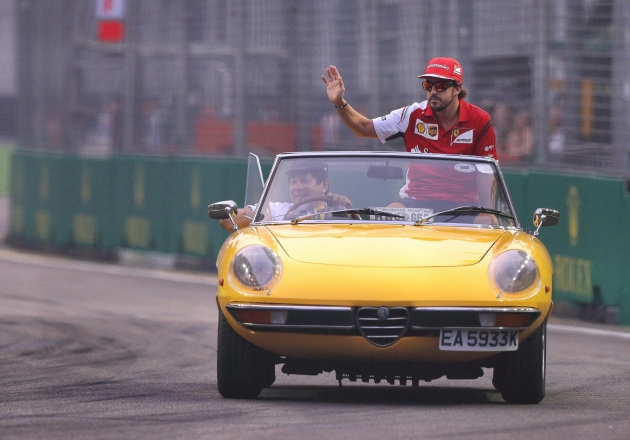 Image data : Canon 70D, Lens- EF300mm F2.8L IS Mk2, 1/3200s, F2.8, ISO1600
Image data : Canon 70D, Lens- EF300mm F2.8L IS Mk2, 1/3200s, F2.8, ISO1600
This one is for the Alonso Fernando fans out there. He was the winner of Singapore’s first night race when it debuted in 2008 and went to win it again in 2010. Cool Spaniard, I say!
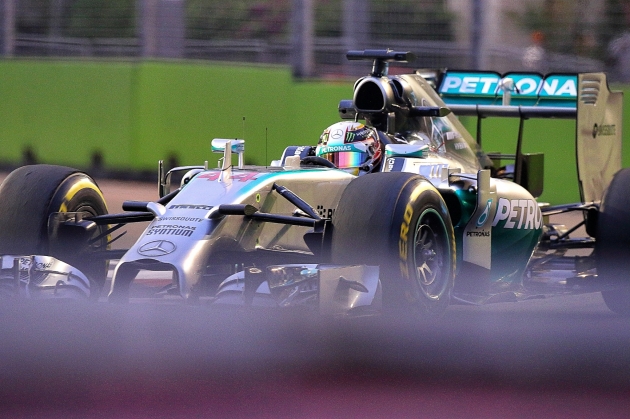 Image data : Canon 70D, Lens- EF300mm F2.8L IS Mk2, 1/1000s, F3.2, ISO1600
Image data : Canon 70D, Lens- EF300mm F2.8L IS Mk2, 1/1000s, F3.2, ISO1600
Lewis Hamilton (No.44) heating up the track. I especially like his colourful helmet visor as it contrasts with his silvery Mercedes steed. One thing that bugs novice photographers at the track is the metal safety grids enveloping the track. In order to “erase” the grids to achieve a clean picture without that caged feeling, a long lens is necessary.
Depending where you are situated along the track, a 300mm-600mm prime lens will be your ticket to “cageless” picture. Of course, shooting at the widest aperture possible also helps in minimising the appearance of the grids’ outlines. Another useful lens is the 70-200mm lens.
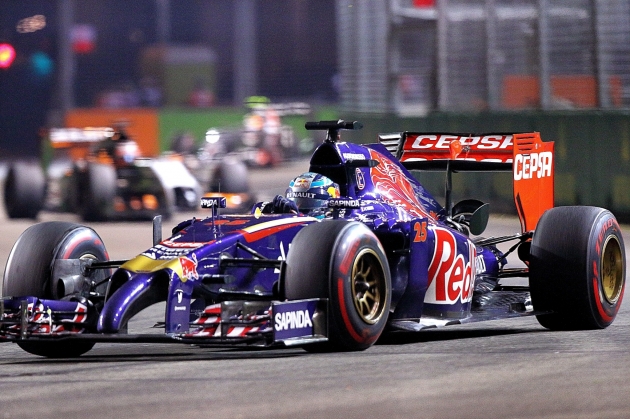 Image data : Canon 70D, Lens- EF300mm F2.8L IS Mk2, 1/800s, F2.8, ISO3200
Image data : Canon 70D, Lens- EF300mm F2.8L IS Mk2, 1/800s, F2.8, ISO3200
To best capture that moment with cars trying to overtake each other, the final day of the race is integral. Station yourself at the turns and get ready when you hear the sounds of the engines around the bend. I tried various focusing modes like Ai-Focus or Ai-Servo (for Canon DSLRs users) and also manual focusing.
Each mode has its benefits and you should use the mode that gives you the best result based on your camera settings and shooting style. For long lens, I strongly recommend a monopod for stability and to minimize fatigue on your arms. A tripod, while good, is not advisable as the picture-taking spots will be crowded and your tripod’s legs may be kicked by other excited photographers or spectators.
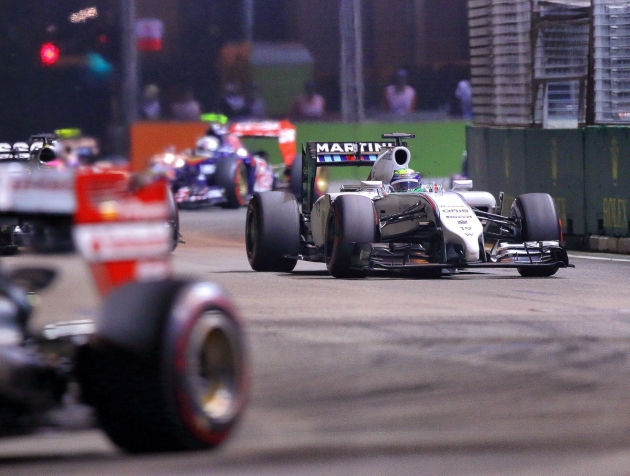 Image data : Canon 70D, Lens- EF300mm F2.8L IS Mk2, 1/1000s, F2.8, ISO2500
Image data : Canon 70D, Lens- EF300mm F2.8L IS Mk2, 1/1000s, F2.8, ISO2500
Use the widest aperture setting possible for the blurred depth of field. This will help with which vehicle you want to emphasize. In this pic, I chose to highlight Felipe Massa (No.19) from team Williams Martini Racing. As in all race pictures, I set the frames speed to high to better capture the right shots (in this case, 7 fps) and in RAW files for better post editing results.
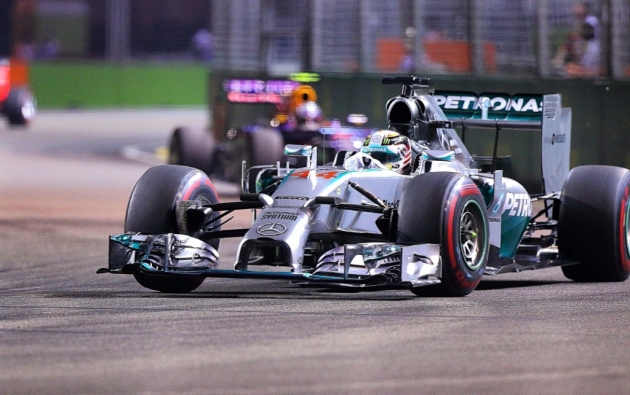 Image data : Canon 70D, Lens- EF300mm F2.8L IS Mk2, 1/800s, F2.8, ISO2500
Image data : Canon 70D, Lens- EF300mm F2.8L IS Mk2, 1/800s, F2.8, ISO2500
This is for the Lewis Hamilton fans out there – you can see him holding on to his pole position as he tears down the track to a podium finish.
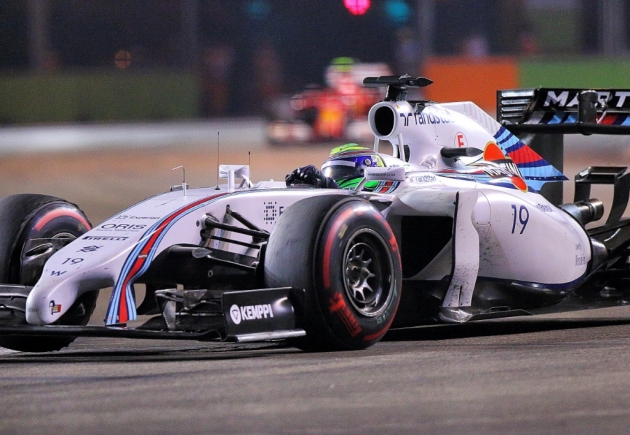 Image data : Canon 70D, Lens- EF300mm F2.8L IS Mk2, 1/1600s, F2.8, ISO3200
Image data : Canon 70D, Lens- EF300mm F2.8L IS Mk2, 1/1600s, F2.8, ISO3200
For all Felipe Massa’s fans. This was shot with manual focus as I pre-focused on the spot where I decided the angle would be. The busy circuit race during that moment almost guaranteed another car in the background.
The camera white balance setting was at AWB as the track light ambience was daylight-type and the camera’s senses were functioning well. The average ISO setting during the night is between 1600-3200.
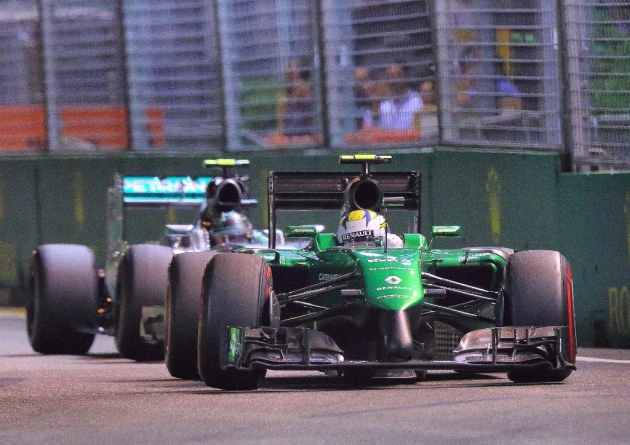 Image data : Canon 70D, Lens- EF300mm F2.8L IS Mk2, 1/1000s, F2.8, ISO3200
Image data : Canon 70D, Lens- EF300mm F2.8L IS Mk2, 1/1000s, F2.8, ISO3200
For team Caterham fans: Swedish driver Marcus Ericcson in the lead. Other than spotting the drivers’ numbers on their cars, the helmet is another way to differentiate a driver from his team mate. Caterham teammate Kamui Kobayashi uses a black/white helmet.
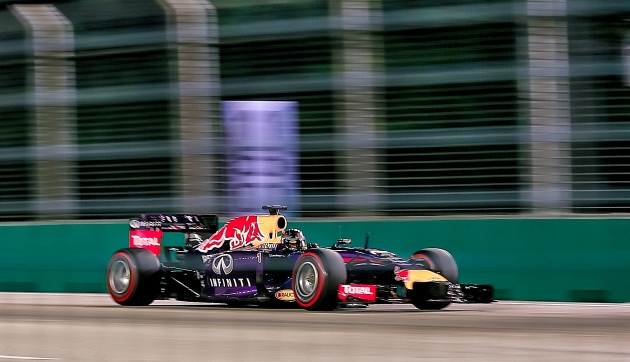 Image data : Canon 1Dx, Lens- EF70-200 F2.8L IS Mk2, 1/100s, F4.0, ISO800; Picture by Patrick Pak
Image data : Canon 1Dx, Lens- EF70-200 F2.8L IS Mk2, 1/100s, F4.0, ISO800; Picture by Patrick Pak
Achieving a clean panned shot of a F1 car at full speed is one of the most satisfying and challenging endeavors for an F1 photographer. Choose the right spot to ensure that the track run allows panning action. This photograph was shot at the stretch fronting Esplanade Drive.
Make sure you go early to secure a spot close to the grids and to be in the first row of spectators. This is important in order to avoid human heads and selfie camera poles being thrust into your line of sight. Set the camera frame speed to the highest and follow the car as it whizzes in front of you. Using a monopod is highly advised.
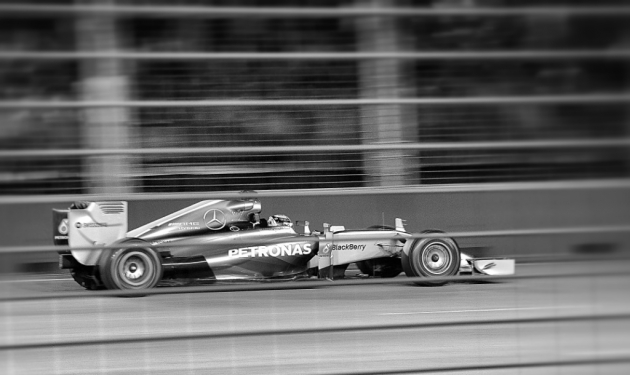 Image data : Canon 70D, Lens- EFS 18-135mm F3.5/5.6 IS STM , 1/125s, F5, ISO500
Image data : Canon 70D, Lens- EFS 18-135mm F3.5/5.6 IS STM , 1/125s, F5, ISO500
I took this shot with the grids visible to impart that “caged fury” feeling. Also, I desaturated the picture during post-process for a monochromatic feel – one reason was that I had forgotten to reset the white balance from Cloudy mode to AWB after the day’s overcast skies, leading the series of panned shots to turn out too warm for my liking.
The black and white rendition turned out nicely.
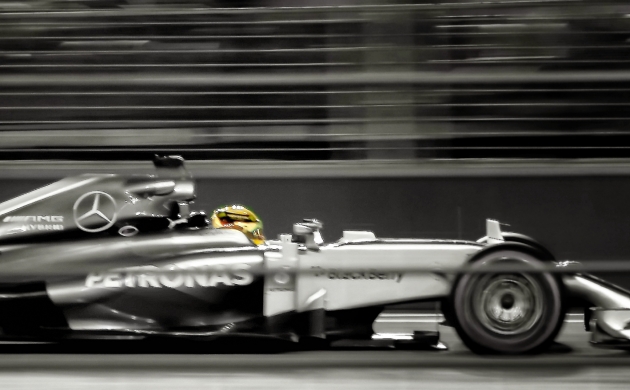 Image data : Canon 70D, Lens- EFS 18-135mm F3.5/5.6 IS STM , 1/125s, F5, ISO500
Image data : Canon 70D, Lens- EFS 18-135mm F3.5/5.6 IS STM , 1/125s, F5, ISO500
I did a little “mood” picture to emphasize the driver. It is a lonely time on the track as the driver speeds 61 laps around the 5.067km track – the drivers may be in constant radio contact with their support crew, but it is still a solitary one-man battle out there.
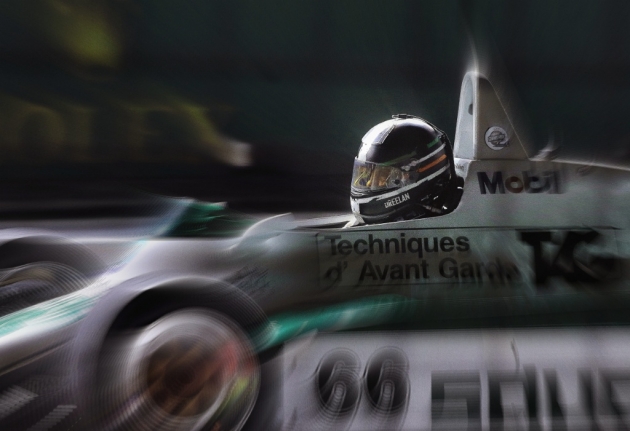 Image data : Canon 70D, Lens- EF300mm F2.8L IS Mk2, 1/1000s, F2.8, ISO3200
Image data : Canon 70D, Lens- EF300mm F2.8L IS Mk2, 1/1000s, F2.8, ISO3200
Another mood shot but of a Historic Masters GP racer as he sped down the track. Moments like this present opportunities for post edit work for a more artistic presentation of the race.
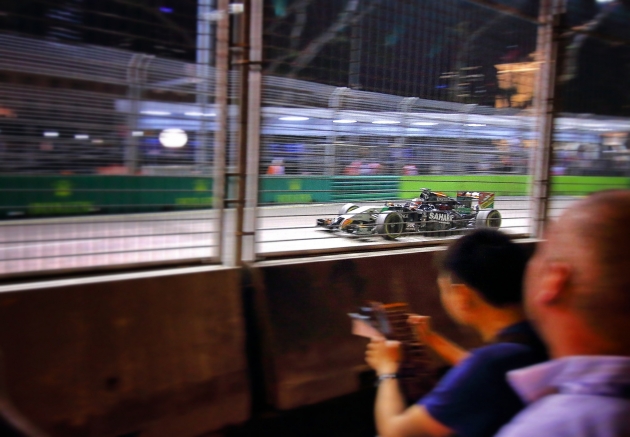 Image data : Canon 70D, Lens- EFS 18-135mm F3.5/5.6 IS STM, 1/125s, F5, ISO500
Image data : Canon 70D, Lens- EFS 18-135mm F3.5/5.6 IS STM, 1/125s, F5, ISO500
You could do panned shots with spectators in the pictures for a feel of the race, but take note of the grid barriers that will affect many of the pictures. Just pan, shoot, and select the best. In this situation when you are near the grids, long lenses become unsuitable and shorter lenses like 18-55mm and 18-135mm come into their own.
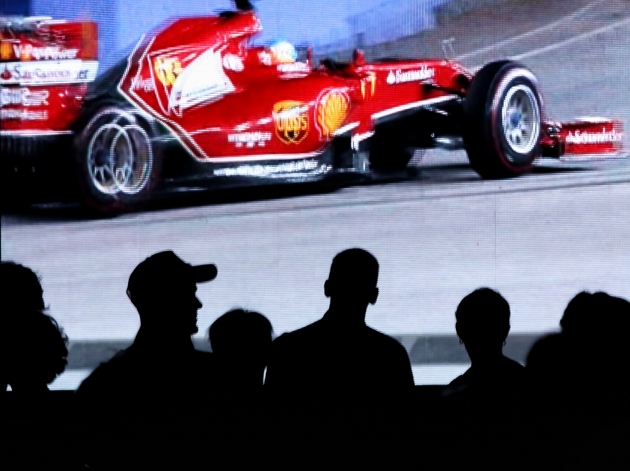 Image data : Canon 70D, Lens- EF300mm F2.8L IS Mk2, 1/20s, F20, ISO400
Image data : Canon 70D, Lens- EF300mm F2.8L IS Mk2, 1/20s, F20, ISO400
Some spectators prefer to view the race at the huge LCD screens at the circuit ground. This makes for interesting silhouettes, but be aware of technical issues when shooting LCD screens. The scanning frequency between TV and camera is different while the phosphor dots are not perceived similarly by the human eye and camera sensor.
The basic thing to note is that shutter speed of about 1/15s or below is needed for proper exposure. I managed to grab a fair record shot on 1/20s on a 300mm lens using a monopod. Not too shabby!
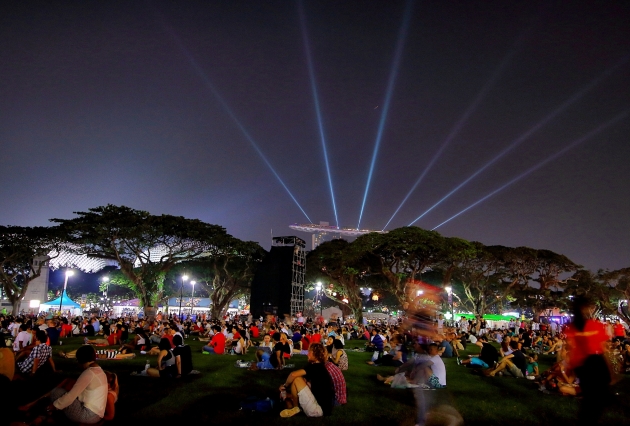 Image data : Canon 70D, Lens- EFS10-18mm F4.5-5.6 IS STM , 1/3s, F5.6, ISO800
Image data : Canon 70D, Lens- EFS10-18mm F4.5-5.6 IS STM , 1/3s, F5.6, ISO800
Spectators at the Padang catching the “live” coverage and waiting for the concert after the race. The Marina Bay Sands laser lighting provided a great backdrop.
Final advice
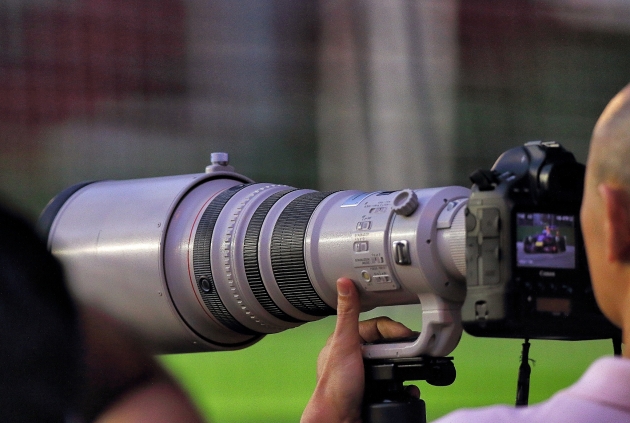 Image data : Canon 70D, Lens- EF300mm F2.8L IS Mk2, 1/800s, F2.8, ISO1600
Image data : Canon 70D, Lens- EF300mm F2.8L IS Mk2, 1/800s, F2.8, ISO1600
At the race, you see numerous long white lens used by advanced or professional photographers. Canon has a long and deep history with Formula One and technological advancements over the years have benefited photographers of all levels. Having used Canon products over the last few years, my respect for the brand has gained a new and even higher level, especially even more so after this F1 event.
I hope readers like the pictures featured in this journal and find the details useful in their future Formula One photography adventures. It is highly advisable to do some research on the best shooting spots. Plan ahead and mingle with fellow experienced photographers for up-to-date tips about the circuit.
For better coverage of the race, I recommend a 3-day pass so that you are able to achieve a wider range of pictures. Of course, wear light clothing, hydrate well, and go with at least 1 buddy to better enjoy the race.
A special mention to Canon Singapore and Canon EOS World for their generous support for the loan of a Canon EF300mm F2.8IS L Mk2 lens for the occasion.
